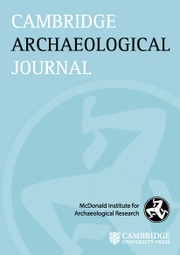Crossref Citations
This article has been cited by the following publications. This list is generated based on data provided by
Crossref.
Rosenberg, Danny
and
Nadel, Dani
2014.
The Sounds of Pounding.
Current Anthropology,
Vol. 55,
Issue. 6,
p.
784.
Atakuman, Çiğdem
2014.
Architectural Discourse and Social Transformation During the Early Neolithic of Southeast Anatolia.
Journal of World Prehistory,
Vol. 27,
Issue. 1,
p.
1.
Rosenberg, Danny
and
Nadel, Dani
2017.
The significance of the morphometric and contextual variation in stone hewn mortars during the Natufian-PPNA transition in the southern Levant.
Quaternary International,
Vol. 439,
Issue. ,
p.
83.
Filin, Sagi
Miller, Vera
Rosenberg, Danny
and
Nadel, Dani
2017.
Intra- and inter-site high-resolution geometrical analyses of Natufian bedrock features.
Quaternary International,
Vol. 439,
Issue. ,
p.
94.
Richter, Tobias
Bocaege, Emmy
Ilsøe, Peter
Ruter, Anthony
Pantos, Alexis
Pedersen, Patrick
and
Yeomans, Lisa
2019.
Ochre, Ground Stone, and Wrapping the Dead in the Late Epipalaeolithic (Natufian) Levant: Revealing the Funerary Practices at Shubayqa 1, Jordan.
Journal of Field Archaeology,
Vol. 44,
Issue. 7,
p.
440.
Dubreuil, Laure
Ovadia, Ahiad
Shahack-Gross, Ruth
Grosman, Leore
and
Petraglia, Michael D.
2019.
Evidence of ritual breakage of a ground stone tool at the Late Natufian site of Hilazon Tachtit cave (12,000 years ago).
PLOS ONE,
Vol. 14,
Issue. 10,
p.
e0223370.
Bekiaris, Tasos
Chondrou, Danai
Ninou, Ismini
and
Valamoti, Soultana-Maria
2020.
Food-processing ground stone tools in the Greek Neolithic and Bronze Age. A synthesis of the published data.
Journal of Greek Archaeology,
Vol. 5,
Issue. ,
Rosenberg, Danny
Chasan, Rivka
Lengyel, György
and
Nadel, Dani
2020.
STONE ‘CANVAS’ AND NATUFIAN ART: AN INCISED HUMAN FIGURE FROM THE NATUFIAN CEMETERY AT RAQEFET CAVE, ISRAEL.
Oxford Journal of Archaeology,
Vol. 39,
Issue. 2,
p.
128.
Rosenberg, Danny
and
Chasan, Rivka
2021.
Between Novelty and Variability: Natufian Hunter-Gatherers (c. 15–11.7 kyr) Proto-Agrotechnology and the Question of Morphometric Variations of the Earliest Sickles.
Proceedings of the Prehistoric Society,
Vol. 87,
Issue. ,
p.
31.
Langgut, Dafna
Cheddadi, Rachid
and
Sharon, Gonen
2021.
Climate and environmental reconstruction of the Epipaleolithic Mediterranean Levant (22.0–11.9 ka cal. BP).
Quaternary Science Reviews,
Vol. 270,
Issue. ,
p.
107170.
Hruby, Karolina
and
Rosenberg, Danny
2023.
Urbanizing food: New perspectives on food processing tools in the Early Bronze Age villages and early urban centers of the southern Levant.
Journal of Anthropological Archaeology,
Vol. 72,
Issue. ,
p.
101549.
Rosenberg, Danny
and
Chasan, Rivka
2024.
Ivories in the Late Chalcolithic Period and Their Significance for Understanding Contacts Between Egypt and the Southern Levant.
Journal of World Prehistory,
Vol. 37,
Issue. 4,
p.
221.
Rosenberg, Danny
and
Garfinkel, Yosef
2025.
Limestone bowls at the dawn of pottery production in the southern Levant: The case of Yarmukian Sha‘ar Hagolan.
Journal of Archaeological Science: Reports,
Vol. 61,
Issue. ,
p.
104997.
Dubreuil, Laure
and
Grosman, Leore
2025.
Natufian architecture 12,000 years ago: Analyzing ‘building stones’ at Nahal Ein Gev II.
Archaeological Research in Asia,
Vol. 41,
Issue. ,
p.
100600.


